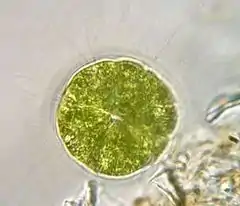Pandorina
Pandorina is a genus of green algae composed of 8, 16, or sometimes 32 cells, held together at their bases to form a sack globular colony surrounded by mucilage. The cells are ovoid or slightly narrowed at one end to appear keystone- or pear-shaped. Each cell has two flagella with two contractile vacuoles at their base, an eyespot, and a large cup-shaped chloroplast with at least one pyrenoid.

| Pandorina | |
|---|---|
 | |
| Colonies of Pandorina morum from Smith (1920, p. 201)[1] | |
| Scientific classification | |
| (unranked): | Viridiplantae |
| Division: | Chlorophyta |
| Class: | Chlorophyceae |
| Order: | Chlamydomonadales |
| Family: | Volvocaceae |
| Genus: | Pandorina Bory de Saint-Vincent, 1824 |
| Species | |
| |
The colonies co-ordinate their flagellar movement to create a rolling, swimming motion. Pandorina shows the beginnings of the colony polarity and differentiation seen in Volvox since the anterior cells have larger eyespots. Molecular sequencing has shown that Pandorina is paraphyletic with respect to Volvulina.[2][3][4]
Asexual reproduction is by simultaneous division of all cells of the colony to form autocolonies that are liberated by a gelatinization of the colonial envelope. Sexual reproduction occurs by division of each cell of the colony into 16-32 zoogametes. Zoogametes show indications of heterogamy, a slight difference in the size and motility of the pairs that fuse to form the smooth walled zygote.[1]
References
- Smith, GM. Phytoplankton of Inland Lakes of Wisconsin, Part I, Wisconsin Geological and Natural History Survey, Madison, WI. (1920).
- Nozaki, H.; Yamada, T. K.; Takahashi, F.; Matsuzaki, R.; Nakada, T. (2014). "New "missing link" genus of the colonial volvocine green algae gives insights into the evolution of oogamy". BMC Evolutionary Biology. 14 (1): 37. doi:10.1186/1471-2148-14-37. PMC 4015742. PMID 24589311.
- Nozaki, H.; Takahara, M.; Nakazawa, A.; Kita, Y.; Yamada, T.; Takano, H.; Kawano, S.; Kato, M. (2002). "Evolution of rbcL group IA introns and intron open reading frames within the colonial Volvocales (Chlorophyceae)". Molecular Phylogenetics and Evolution. 23 (3): 326–38. doi:10.1016/S1055-7903(02)00030-1. PMID 12099791.
- Coleman, A. W. (2001). "Biogeography and Speciation in the Pandorina/volvulina (Chlorophyta) Superclade". Journal of Phycology. 37 (5): 836–851. doi:10.1046/j.1529-8817.2001.01043.x.
External links
- Pandorina - description with pictures
- algaebase on Pandorina
- Coleman, A.W. (2001) "Biogeography and Speciation in the pandorina/volvulina (Chlorophyta) Superclade", Journal of Phycology, 37(5), October 2001, pp. 836–851